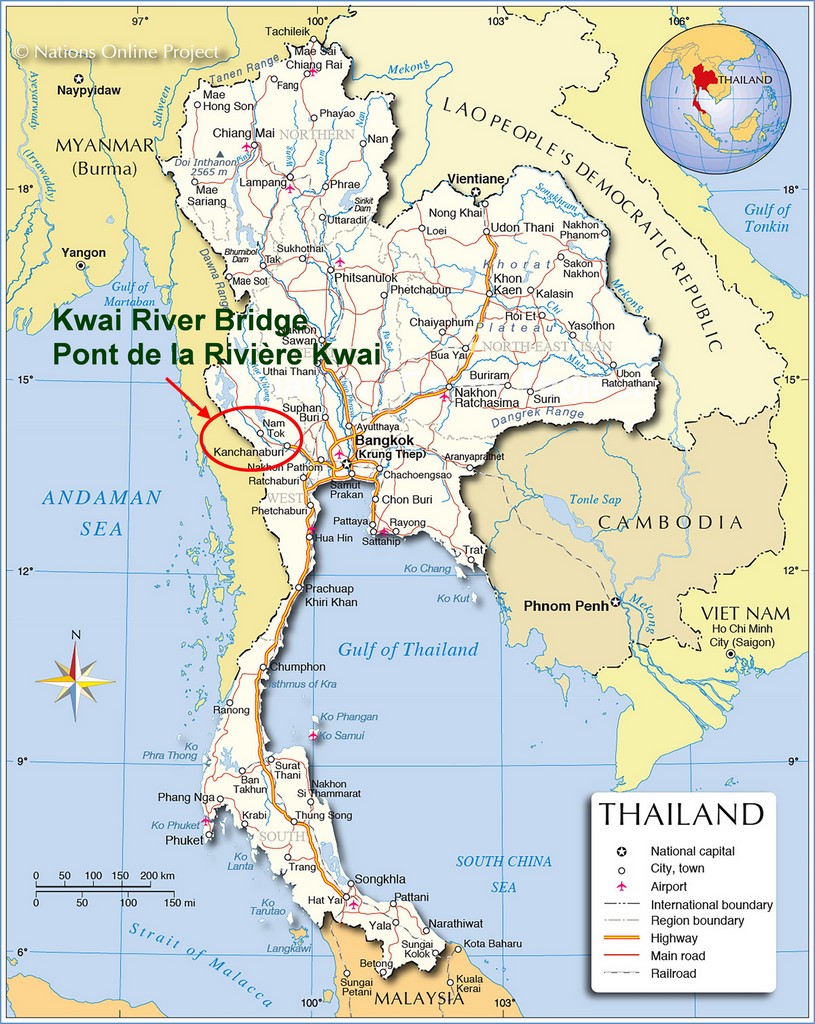The Train of Death, Kanchanaburi
 A film that has marked a generation...
A film that has marked a generation...

For people of my generation, it is clear that when we talk about "The Kwai River Bridge" we immediately think of the 1957 film directed by David Lean, but also of the music of the film which was regularly whistling by many people on the street....
For a long time, this title only referred to the hit film that everyone knows and nothing else. Even today, we still make the connection with the film and it is inevitable.
Unfortunately, this story of a prison camp lost somewhere in the depths of Asia, without anyone knowing exactly where, was very real.
Even today, many people still do not know where this famous bridge on the Kwai River is located and are often surprised to learn that it is located in Thailand, three hours' drive west of Bangkok...
Colonel Nicholsson (Alec Guiness) probably never existed, the bamboo bridge maybe either, who knows....
The film of course distorted reality, it's normal... classic technique: we use a frame and a story and we arrange all this in a Hollywood style.
At the time, Asia was so far away... it took several days to get there and it was a long and tiring battle course. Very few people went to these regions to do tourism, which only increased the imagination of the film.
The French writer, Pierre Boulle, was far from thinking that his novel would be such a success in American cinema. It was not the only success he experienced, since a few years later, he wrote the novel "La Planète des Singes" which has since made its way.
Since the release of this film, the title "The Kwai River Bridge" has always been a dream and still is. I read these days on an English website that even today, this destination remains one of the priorities for many tourists arriving in Thailand for the first time.
Just look at the number of tourists walking on the bridge in Kanchanaburi, having their picture taken and contemplating the metal structure, which has nothing to do with the film itself, which was made of bamboo...
The few pictures I propose today will show you the bridge itself, but also and especially the railway built on a long and impressive viaduct leaning against the cliffs overlooking the Kwai River.
 The River Kwai Bridge in Kanchanaburi
The River Kwai Bridge in Kanchanaburi

The small station, "Kwai River Station", is located about 100 metres before the bridge.
 Bridge on the River Kwai
Bridge on the River Kwai




It is rare that the Kwai River Bridge is deserted as in this photo.
Most of the time, dozens of onlookers walk on this metal framework
to have their picture taken (I did it too...)


Old vintage locomotives... exposed a few meters from the bridge


On the opposite bank, a memorial dedicated to Chinese soldiers
 Kanchanaburi: The Death Train
Kanchanaburi: The Death Train

Heading north from Kanchanaburi, about 45km away, we find a very impressive place at Thamkrasae Bridge with a view of the wooden viaduct and its sturdy pillars.
Following the vertiginous side of the cliff along the Kwai River, the route must have been conquered by hand on the jungle by the prisoners.
I must admit that the visit to this place, in a superb surrounding, is quite moving.
The Thai portion is about 300 km long. Construction took one year, from October 1942 to October 1943.
Part of the line was dismantled. Another part was submerged during the construction of the Khao Laem dam.
The scenery along the railway line is beautiful, especially at Tham Krasae cave where it runs along the rock walls on one side and the Kwai Noi River on the other.
Today this line has its terminus at Ban Tha Sao at Namtok station. It is 77 km long. Thai Railways operates the line daily.
There is an extra train from Bangkok to Namtok every Saturday, Sunday and public holidays.




 The Military Cemetery in Kanchanaburi
The Military Cemetery in Kanchanaburi





 On the Map
On the Map

Province of Kanchanaburi





